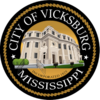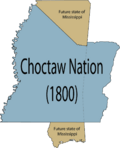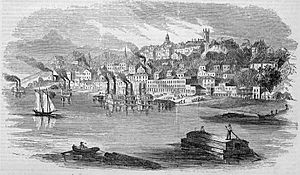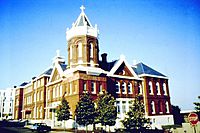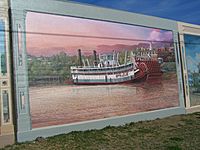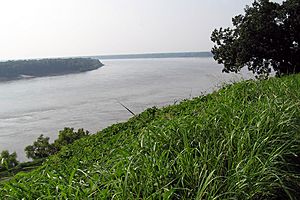Vicksburg, Mississippi facts for kids
Quick facts for kids
Vicksburg, Mississippi
|
|||
|---|---|---|---|
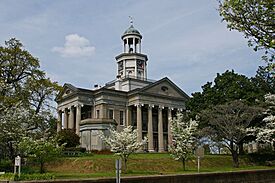
Old Warren County Courthouse ("Old Courthouse Museum")
|
|||
|
|||
| Nickname(s):
"Gibraltar of the Confederacy", "Red Carpet City of the South"
|
|||
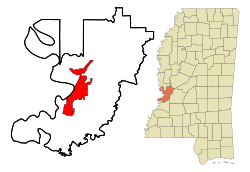
Location of Vicksburg in Warren County, Mississippi
|
|||
| Country | United States | ||
| State | Mississippi | ||
| County | Warren | ||
| Founded | 1811 | ||
| Incorporated | January 29, 1825 | ||
| Named for | Newitt Vick | ||
| Area | |||
| • City | 35.093 sq mi (90.890 km2) | ||
| • Land | 33.017 sq mi (85.513 km2) | ||
| • Water | 2.076 sq mi (5.377 km2) | ||
| Elevation | 200 ft (60 m) | ||
| Population
(2020)
|
|||
| • City | 21,573 | ||
| • Estimate
(2023)
|
20,192 | ||
| • Density | 611.49/sq mi (236.10/km2) | ||
| • Urban | 25,888 | ||
| • Metro | 42,298 (US: 296th) | ||
| Time zone | UTC−6 (Central (CST)) | ||
| • Summer (DST) | UTC−5 (CDT) | ||
| ZIP Codes |
39180, 39181, 39182, 39183
|
||
| Area code(s) | 601 and 769 | ||
| FIPS code | 28-76720 | ||
| GNIS feature ID | 2405648 | ||
| Sales tax | 7.0% | ||
Vicksburg is a historic city in Warren County, Mississippi, United States. It is the county seat. The population was 21,573 at the 2020 census. Located on a high bluff on the east bank of the Mississippi River across from Louisiana, Vicksburg was built by French colonists in 1719. The outpost withstood an attack from the native Natchez people. It was incorporated as Vicksburg in 1825 after Methodist missionary Newitt Vick. The area that is now Vicksburg was long occupied by the Natchez Native Americans as part of their historical territory along the Mississippi. The first Europeans who settled the area were French colonists who built Fort Saint Pierre in 1719 on the high bluffs overlooking the Yazoo River at present-day Redwood. They conducted fur trading with the Natchez and others, and started plantations. During the American Civil War, it was a key Confederate river-port, and its July 1863 surrender to Ulysses S. Grant, along with the concurrent Battle of Gettysburg, marked the turning-point of the war.
After the war came the Reconstruction era and then a violent return to power by white supremacists and the Democratic Party in 1874 and 1875, including the Vicksburg massacre. Today, Vicksburg's population is majority African American. The city is home to three large installations of the United States Army Corps of Engineers, which has often been involved in local flood control.
Contents
History
The area which is now Vicksburg was long occupied by the Natchez Native Americans as part of their historical territory along the Mississippi. The Natchez spoke a language isolate not related to the Muskogean languages of the other major tribes in the area. Before the Natchez, other indigenous cultures had occupied this strategic area for thousands of years.
The first Europeans who settled the area were French colonists, who built Fort-Saint-Pierre in 1719 on the high bluffs overlooking the Yazoo River at present-day Redwood. They conducted fur trading with the Natchez and others and started plantations. On 29 November 1729, the Natchez attacked the fort and plantations in and around the present-day city of Natchez. They killed several hundred settlers, including the Jesuit missionary Father Paul Du Poisson. As was the custom, they took a number of women and children as captives.
The Natchez War was a disaster for French Louisiana, and the colonial population of the Natchez District never recovered. But, aided by the Choctaw, traditional enemies of the Natchez, the French defeated and scattered the Natchez and their allies, the Yazoo.
The Choctaw Nation took over the area by right of conquest and inhabited it for several decades. Under pressure from the US government, in 1801 the Choctaw agreed to cede nearly 2,000,000 acres (8,100 km2) of land to the US under the terms of the Treaty of Fort Adams. The treaty was the first of a series that eventually led to the removal in 1830 of most of the Choctaw to Indian Territory west of the Mississippi River. Some Choctaw remained in Mississippi, citing article XIV of the Treaty of Dancing Rabbit Creek; they became citizens of the state and the United States. They struggled to maintain their culture against the pressure of the binary slave society, which classified people as only white or black.
In 1790, the Spanish founded a military outpost on the site, which they called Fort Nogales (nogales meaning "walnut trees"). When the Americans took possession in 1798 following the American Revolutionary War and a treaty with Spain, they changed the name to Walnut Hills. The small village was incorporated in 1825 as Vicksburg, named after Newitt Vick, a Methodist minister who had established a Protestant mission on the site.
In 1835, during the Murrell Excitement, a mob from Vicksburg attempted to expel the gamblers from the city, because the citizens were tired of the rougher element treating the city residents with nothing but contempt. They captured and hanged five gamblers who had shot and killed a local doctor. The historian Joshua D. Rothman calls this event "the deadliest outbreak of extralegal violence in the slave states between the Southampton Insurrection and the Civil War."
During the American Civil War, the city finally surrendered during the Siege of Vicksburg, after which the Union Army gained control of the entire Mississippi River. The 47-day siege was intended to starve the city into submission. Its location atop a high bluff overlooking the Mississippi River proved otherwise impregnable to assault by federal troops. The surrender of Vicksburg by Confederate General John C. Pemberton on July 4, 1863, together with the defeat of General Robert E. Lee at Gettysburg the day before, has historically marked the turning point in the Civil War in the Union's favor.
Some accounts say that the residents of Vicksburg did not celebrate the national holiday of 4th of July again until 1945, after United States victory in World War II, but this is inaccurate. Large Fourth of July celebrations were being held by 1907, and informal celebrations took place before that.
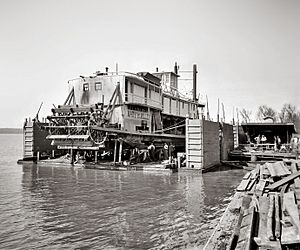
Because of the city's location on the Mississippi River, in the 19th century it built an extensive trade from the prodigious steamboat traffic. It shipped out cotton coming to it from surrounding counties and was a major trading city.
In 1876 a Mississippi River flood cut off the large meander flowing past Vicksburg, leaving limited access to the new channel. The city's economy suffered greatly. Between 1881 and 1894, the Anchor Line, a prominent steamboat company on the Mississippi River from 1859 to 1898, operated a steamboat called the City of Vicksburg.
Political and racial unrest after the Civil War
In the first few years after the Civil War, white Confederate veterans developed the Ku Klux Klan, beginning in Tennessee; it had chapters throughout the South and attacked blacks and their supporters. It was suppressed about 1870. By the mid-1870s, new white paramilitary groups had arisen in the Deep South, including the Red Shirts in Mississippi, as whites struggled to regain political and social power over the black majority. Elections were marked by violence and fraud as whites worked to suppress black Republican voting.
Nonetheless, in August 1874 a black sheriff, Peter Cosby, was elected in Vicksburg. Letters by a white planter, Batchelor, detail the preparations of whites for what he described as a "race war," including acquisition of the newest guns, Winchester 16 mm. On December 7, 1874, white men disrupted a black Republican meeting celebrating Cosby's victory and held him in custody before running him out of town. He advised blacks from rural areas to return home; along the way, some were attacked by armed whites. During the next several days, armed white mobs swept through black areas, killing other men at home or out in the fields. Sources differ as to total fatalities, with 29-50 blacks and 2 whites reported dead at the time. Twenty-first century historian Emilye Crosby estimates that 300 blacks were killed in the city and the surrounding area of Claiborne County. The Red Shirts were active in Vicksburg and other Mississippi areas, and black pleas to the federal government for protection were not met.
At the request of Governor Adelbert Ames, who had left the state during the violence, President Ulysses S. Grant sent Federal troops to Vicksburg in January 1875. In addition, a congressional committee investigated what was called the Vicksburg Riot at the time (and reported as the Vicksburg Massacre by northern newspapers.) They took testimony from both black and white residents, as reported by the New York Times, but no one was ever prosecuted for the deaths. The Red Shirts and other white insurgents suppressed Republican voting by both whites and blacks; smaller-scale riots were staged in the state up to the 1875 elections, at which white Democrats took back control of the state legislature. Due to their success, other southern states adopted what they called the "Mississippi Plan", an organized effort to suppress the black vote and unite whites under the Democrats.
Under new constitutions, amendments and laws passed from 1890 (Mississippi) to 1908 in the remaining southern states, white Democrats disenfranchised most blacks and many poor whites by creating barriers to voter registration, such as poll taxes, literacy tests and grandfather clauses. They passed laws imposing Jim Crow and racial segregation of public facilities.
20th century to present
The near exclusion of most blacks from the political system lasted for decades until after Congressional passage of civil rights legislation in the mid-1960s.
The United States Army Corps of Engineers diverted the Yazoo River in 1903 into the old, shallowing channel to rejuvenate the waterfront of Vicksburg. Railroad access to the west across the river continued to be by transfer steamers and ferry barges until a combination railroad-highway bridge was built in 1929. Vicksburg has the only crossing over the Mississippi River between Baton Rouge and Memphis. It is the only highway crossing of the river between Greenville and Natchez.
Interstate 20 bridged the river after 1973. Freight rail traffic still crosses via the old bridge. North-South transportation links are by the Mississippi River and U.S. Highway 61.
On March 12, 1894, the popular soft drink Coca-Cola was bottled for the first time in Vicksburg by Joseph A. Biedenharn, a local confectioner. Today, surviving 19th-century Biedenharn soda bottles are prized by collectors of Coca-Cola memorabilia. His original candy store has been renovated as the Biedenharn Coca-Cola Museum.
During the Great Mississippi Flood of 1927, in which hundreds of thousands of acres were inundated, Vicksburg served as the primary gathering point for refugees. Relief parties put up temporary housing, as the flood submerged a large percentage of the Mississippi Delta.
Because of the overwhelming damage from the flood, the US Army Corps of Engineers established the Waterways Experiment Station as the primary hydraulics laboratory, to develop protection of important croplands and cities. Now known as the Engineer Research and Development Center, it applies military engineering, information technology, environmental engineering, hydraulic engineering, and geotechnical engineering to problems of flood control and river navigation.
In December 1953, a severe tornado swept across Vicksburg, causing 38 deaths and destroying nearly 1,000 buildings.
Lynchings and other forms of vigilante violence continued to occur in Vicksburg after the start of the 20th century. In May 1903, for instance, two black men charged with murdering a planter were taken from jail by a mob of 200 farmers and lynched before they went to trial.
Particularly after World War II, in which many blacks served, returning veterans began to be active in the civil rights movement, wanting to have full citizenship after fighting in the war. In Mississippi, activists in the Vicksburg Movement became prominent during the 1960s.
Contemporary Vicksburg
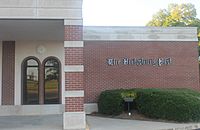
In 2001, a group of Vicksburg residents visited the Paducah, Kentucky mural project, looking for ideas for their own community development. In 2002, the Vicksburg Riverfront murals program was begun by Louisiana mural artist Robert Dafford and his team on the floodwall located on the waterfront in downtown. Subjects for the murals were drawn from the history of Vicksburg and the surrounding area. They include President Theodore Roosevelt's bear hunt, the Sultana, the Sprague, the Siege of Vicksburg, the Kings Crossing site, Willie Dixon, the Flood of 1927, the 1953 Vicksburg, Mississippi tornado outbreak, Rosa A. Temple High School (known for integration activism) and the Vicksburg National Military Park. The project was finished in 2009 with the completion of the Jitney Jungle/Glass Kitchen mural.
In the fall of 2010, a new 55-foot mural was painted on a section of wall on Grove Hill across the street from the original project by former Dafford muralists Benny Graeff and Herb Roe. The mural's subject is the annual "Run thru History" held in the Vicksburg National Military Park.
On December 6–7, 2014, a symposium was held on the 140th anniversary of the Vicksburg Riots of 1874. A variety of scholars gave papers and an open panel discussion was held on the second day at the Vicksburg National Military Park, in collaboration with the Jacqueline House African American Museum.
Geography
Vicksburg is located at 32°20′10″N 90°52′31″W / 32.33611°N 90.87528°W (32.335986, -90.875356). According to the United States Census Bureau, the city has a total area of 35.3 square miles (91 km2), of which 32.9 square miles (85.2 km²) is land and 2.4 square miles (6.2 km2) (6.78%) is water.
Vicksburg is located at the confluence of the Mississippi River and Yazoo River. Much of the city is on top of a high bluff on the east bank of the Mississippi River.
Demographics
| Historical population | |||
|---|---|---|---|
| Census | Pop. | %± | |
| 1850 | 3,678 | — | |
| 1860 | 4,591 | 24.8% | |
| 1870 | 12,443 | 171.0% | |
| 1880 | 11,814 | −5.1% | |
| 1890 | 13,373 | 13.2% | |
| 1900 | 14,834 | 10.9% | |
| 1910 | 20,814 | 40.3% | |
| 1920 | 18,072 | −13.2% | |
| 1930 | 22,943 | 27.0% | |
| 1940 | 24,460 | 6.6% | |
| 1950 | 27,948 | 14.3% | |
| 1960 | 29,143 | 4.3% | |
| 1970 | 25,478 | −12.6% | |
| 1980 | 25,434 | −0.2% | |
| 1990 | 20,908 | −17.8% | |
| 2000 | 26,407 | 26.3% | |
| 2010 | 23,856 | −9.7% | |
| 2020 | 21,573 | −9.6% | |
| 2023 (est.) | 20,192 | −15.4% | |
| U.S. Decennial Census 2020 Census |
|||
As of the 2022 American Community Survey, there are 8,092 estimated households in Vicksburg with an average of 2.57 persons per household. The city has a median household income of $45,147. Approximately 25.5% of the city's population lives at or below the poverty line. Vicksburg has an estimated 55.1% employment rate, with 25.3% of the population holding a bachelor's degree or higher and 86.1% holding a high school diploma.
The top five reported ancestries (people were allowed to report up to two ancestries, thus the figures will generally add to more than 100%) were English (94.3%), Spanish (2.9%), Indo-European (1.8%), Asian and Pacific Islander (0.1%), and Other (0.8%).
The median age in the city was 37.6 years.
2020 census
| Race | Num. | Perc. |
|---|---|---|
| White | 5,974 | 27.69% |
| Black or African American | 14,423 | 66.86% |
| Native American | 27 | 0.13% |
| Asian | 209 | 0.97% |
| Other/Mixed | 537 | 2.49% |
| Hispanic or Latino | 403 | 1.87% |
As of the 2020 United States Census, there were 21,573 people, 8,969 households, and 4,864 families residing in the city.
Economy
The city is home to three large US Army Corps of Engineers installations: the Engineer Research and Development Center (ERDC), which also houses the ERDC's Waterways Experiment Station; the Mississippi Valley Division headquarters; and the Vicksburg District headquarters.
The 412th Engineer Command of the US Army Reserve and the 168th Engineer Brigade of the Mississippi Army National Guard are also located in Vicksburg.
The United States Coast Guard's 8th District/Lower Mississippi River sector has an Aids To Navigation unit located in Vicksburg, operating the buoy tending vessel USCGC Kickapoo.
In 2017, Emma Green of The Atlantic stated, "The Army Corps of Engineers sustains the town economically". 12.3% of the local workforce is employed by the federal government.
Casinos
Vicksburg is the home of four casinos along the Mississippi River.
- Ameristar Casino Vicksburg
- Casino Vicksburg (formerly Lady Luck Casino Vicksburg)
- Riverwalk Casino Hotel
- Water View Casino
Arts and culture
Annual cultural events
Every summer, Vicksburg plays host to the Miss Mississippi Pageant and Parade. Also every summer, the Vicksburg Homecoming Benevolent Club hosts a homecoming weekend/reunion that provides scholarships to graduating high-school seniors. Former residents from across the country return for the event.
Every summer since 1936, Vicksburg Theatre Guild has hosted Gold in the Hills, which holds the Guinness World Record for longest-running show.
Places of interest
- Vicksburg City Hall, a 1902 Beaux-Arts Classical Revival style, by architect James Riely Gordon.
- Anchuca Mansion (1830)
- Balfour House (1835)
- Beck House (1875)
- The Magnolias (c. 1877–1880)
- McRaven House (c. 1797)
- Old Court House Museum (1861)
- Vicksburg National Military Park
- Pemberton's Headquarters
- U.S.S. Cairo Gunboat & Museum
- Vicksburg Riverfront Murals (2002, 2012)
- Vicksburg Theatre Guild
Education
K-12 schools
The City of Vicksburg is served by the Vicksburg-Warren School District.
- Vicksburg High School
- 1988–1989 National Blue Ribbon School
- Warren Central High School
- Vicksburg Junior High School
- Warren Central Junior High School
- Academy of Innovation
- Beechwood Elementary School
- Bovina Elementary School
- Bowmar Avenue Magnet School
- Dana Road Elementary School
- Redwood Elementary School
- Sherman Avenue Elementary School
- South Park Elementary School
- Warrenton Elementary School
- Vicksburg Intermediate School
- Warren Central Intermediate School
- Porters Chapel Academy
- Vicksburg Catholic School - St. Francis Xavier Elementary and Saint Aloysius Catholic High School (of the Roman Catholic Diocese of Jackson)
- Vicksburg Christian Academy
- Vicksburg Community School (K-12)
- Hall's Ferry Road Elementary School
- 1985–1986, National Blue Ribbon School
- Culkin Elementary School
- Jett Elementary School
- Cedars Elementary School
- Vicksburg Middle School
- All Saints' Episcopal School was a local boarding school located on Confederate Avenue, which closed in 2006 after 98 years in operation. The historic school is now a regional campus for AmeriCorps NCCC.
- St. Mary's Catholic School served the African-American community.
- McIntyre Elementary School served the African-American community.
- Magnolia Avenue School serviced the African-American community and was renamed Bowman High School to honor a former principal.
- Rosa A. Temple High School served the African-American community.
- King's Elementary School served the African-American community.
- Carr Central High School.
- J.H. Culkin Academy (grades 1-12 until 1965, thereafter Culkin Elementary School).
- H.V. Cooper High School. First graduating class 1959.
- Jefferson Davis School.
- Oak Ridge School.
- Eliza Fox School (a.k.a. Grove Street School).
- All Saints' College. An Episcopal college for white women. Opened in 1908 and closed in 1962.
Colleges and universities
Warren County is in the district of Hinds Community College.
Media
Newspapers
The Vicksburg Post, formerly the Vicksburg Evening Post.
Radio
Television
Transportation
The Yazoo and Mississippi Valley Railroad and then the Illinois Central Railroad for several decades had passenger service through the city, at two different stations, one on Levee Street, and the other on Cherry Street. The IC's Planter went north to Memphis, Tennessee and south to New Orleans. The Chery Street station hosted the Northeastern Limited and an unnamed train east to Jackson and Meridian (sleeping car passengers could continue to New York; coach passengers could transfer at Meridian's Union Station to an Atlanta and New York bound train there), and the Southwestern Limited and another train west to Monroe and Shreveport's Union Station. The final train serving Vicksburg was the Southwestern Limited/Northeastern Limited in 1967.
Interstate 20 runs east–west through the southern part of Vicksburg. U.S. Highway 80 runs east–west through the city. U.S. Highway 61 runs north–south through the city.
The nearest airport with commercial flights is Jackson–Medgar Wiley Evers International Airport, 53.2 miles to the east of Vicksburg. Vicksburg Tallulah Regional Airport and Vicksburg Municipal Airport, to the west and to the south of Vicksburg, are, on the other hand, two general aviation airports.
Notable people
- William Wirt Adams, Confederate Army officer and member of the Mississippi House of Representatives
- Katherine Bailess, actress, singer and dancer
- Earle Basinsky, crime novelist
- Ed Bearss (1923–2020), American Civil War historian
- Joseph A. Biedenharn (1866–1952), entrepreneur: first bottled Coca-Cola in 1894 in Vicksburg
- Johnny Brewer, football player
- Margaret Hunt Brisbane (1858–1925), poet
- Roosevelt Brown, former Major League Baseball outfielder for the Chicago Cubs
- Ellis Burks, former MLB outfielder
- Charles Burnett, filmmaker
- Malcolm Butler, cornerback for the New England Patriots and Tennessee Titans
- Odia Coates, pop singer
- Rod Coleman, defensive tackle for the Atlanta Falcons
- Caroline Russell Compton, Mississippi artist
- Mart Crowley, playwright, TV executive
- Jefferson Davis, President of the Confederate States of America
- Bobby DeLaughter, Mississippi state judge and prosecutor
- Willie Dixon, blues bassist, singer, songwriter, and producer
- John "Kayo" Dottley, college and professional football player
- Myrlie Evers-Williams, civil rights activist and journalist
- Charley Fuller, former NFL running back
- Mark Gray, country music singer, born in Vicksburg
- Louis Green, linebacker for the Denver Broncos
- DeMichael Harris, wide receiver for the Indianapolis Colts
- Milt Hinton, jazz bassist
- Jay Hopson, football head coach, University of Southern Mississippi
- Joseph Holt, longest-serving Judge Advocate General of the Army
- Delbert Hosemann Jr., Lt Governor of Mississippi
- Hank Jones, jazz pianist, born in Vicksburg
- Martin F. Jue, amateur radio products inventor, entrepreneur
- Patrick Kelly, fashion designer
- Brad Leggett, football player, Seattle Seahawks
- George McConnell, former guitarist for Widespread Panic, Kudzu Kings, and Beanland
- William Michael Morgan, country music singer
- Michael Myers, defensive tackle for the Cincinnati Bengals
- Key Pittman, U.S. Senator from Nevada, 1913–40; born in Vicksburg
- Vail M. Pittman, 19th Governor of Nevada
- Dave Plump, former NFL defensive back, San Diego Chargers
- Evelyn Preer, African-American film actress
- George Reed former running back for the Canadian Football League
- Beah Richards, African-American film and television actress
- Kee Sloan, Episcopal priest and eleventh Bishop of Alabama
- Roy C. Strickland, businessman and politician in Louisiana and Texas
- Taylor Tankersley, Florida Marlins relief pitcher
- John Thomas, former MLB player
- Mary T. Washington, the first African-American woman CPA
- Carl Westcott, entrepreneur, founder of 1-800-Flowers and Westcott Communications
- Delmon Young, outfielder for the Philadelphia Phillies
- Dmitri Young, first baseman for the Washington Nationals
- Jaelyn Young, pleaded guilty to charges relating to her attempts to join ISIS
See also
 In Spanish: Vicksburg para niños
In Spanish: Vicksburg para niños



